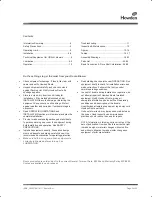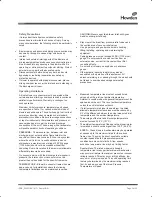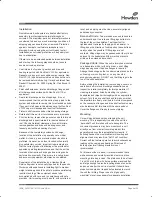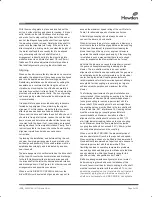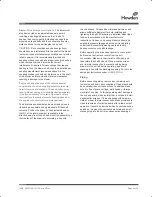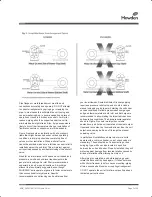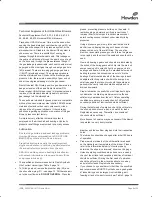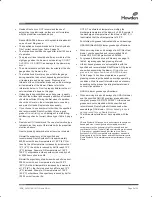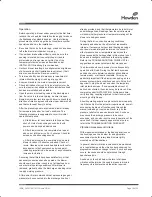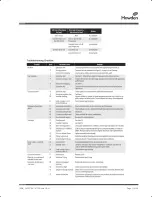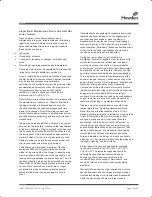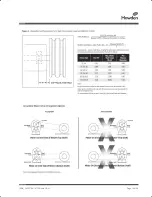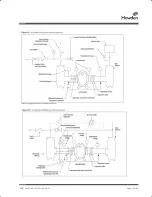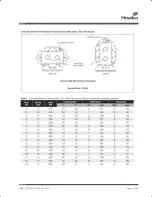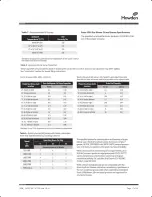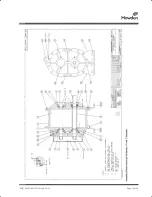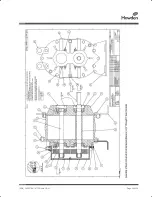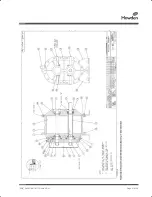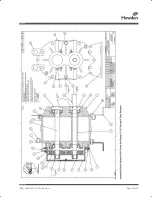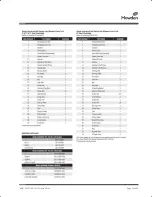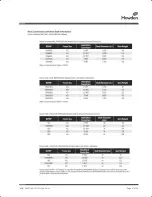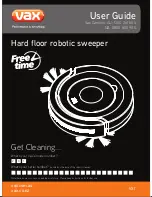
ISRB_2002 GEA 19171 Roots URAI
Page 12 of 32
Inspection & Maintenance: Roots Universal RAI
series blowers
A good program of consistent inspection and
maintenance is the most reliable method of minimizing
repairs to a blower. A simple record of services and
dates will help keep this work on a regular schedule.
Basic service needs are:
Lubrication
Checking for hot spots
Checking for increases or changes in vibration and
noise
Recording of operating pressures and temperatures
Above all, a blower must be operated within its specified
rating limits, to obtain satisfactory service life.
A newly installed blower should be checked often during
the first month of full-time operation. Attention thereafter
may be less frequent assuming satisfactory
performance. Lubrication is normally the most important
consideration and weekly checks of lubricant levels in
the gearbox and bearing reservoirs should be
customary. Complete oil change schedules are
discussed under
LUBRICATION.
Driver lubrication practices should be in accordance with
the manufacturer’s instructions. If direct connected to
the blower through a lubricated type coupling, the
coupling should be checked and greased each time
blower oil is changed. This will help reduce wear and
prevent unnecessary vibration. In a belted drive system,
check belt tension periodically and inspect for frayed or
cracked belts.
In a new, and properly installed, unit there is no contact
between the two impellers, or between the impellers and
cylinder or headplates. Wear is confined to the bearings
(which support and locate the shafts) the oil seals, and
the timing gears. All are lubricated and wear should be
minimal if clean oil of the correct grade is always used.
Seals are subject to deterioration as well as wear, and
may require replacement at varying periods.
Shaft bearings are designed for optimum life under
average conditions with proper lubrication and are
critical to the service life of the blower. Gradual bearing
wear may allow a shaft position to change slightly, until
rubbing develops between impeller and casing. This will
cause spot heating, which can be detected by observing
these surfaces. Sudden bearing failure is usually more
serious. Since the shaft and impeller are no longer
supported and properly located, extensive general
damage to the blower casing and gears is likely to
occur.
Oil seals should be considered expendable items, to be
replaced whenever drainage from the headplate vent
cavity becomes excessive or when the blower is
disassembled for any reason. Some oil seal leakage
may occur since an oil film under the lip is required for
proper operation. Periodically leaked oil should be wiped
off from surfaces. Minor seal leakage should not be
considered as indicating seal replacement.
Timing gear wear, when correct lubrication is
maintained, should be negligible. Gear teeth are cut to
provide the correct amount of backlash, and gears
correctly mounted on the shafts will accommodate a
normal amount of tooth wear without permitting contact
between lobes of the two impellers. However, too high
an oil level will cause churning and excessive heating.
This is indicated by unusually high temperature at the
bottom of the gear housing. Consequent heating of the
gears will result in loss of tooth-clearance, backlash and
rapid wear of the gear teeth usually will develop.
Continuation of this tooth wear will eventually produce
impeller contacts (knocking), and from this point serious
damage will be unavoidable if blower operation is
continued. A similar situation can be produced suddenly
by gear tooth fracture, which is usually brought on by
sustained overloading or momentary shock loads.
Problems may also develop from causes other than
internal parts failure. Operating clearances within a
blower are only a few thousandths of an inch. This
makes it possible for impeller interference or casing rubs
to result from shifts in the blower mounting or from
changes in piping support. If this type of trouble is
experienced, and the blower is found to be clean, try
removing mounting strains. Loosen blower mounting
bolts and reset the levelling and drive alignment. Then
tighten mounting again, and make sure that all piping
meets blower connections accurately and squarely
Foreign materials in the blower will also cause trouble,
which can only be cured by disconnecting the piping and
thoroughly cleaning the blower interior.
A wide range of causes and solutions for operating
troubles are covered in the
TROUBLE SHOOTING
CHECKLIST.
The remedies suggested should be
performed by qualified mechanics with a good
background. Major repairs generally are to be
considered beyond the scope of maintenance, and
should be referred to an authorized Howden Roots
distributor.
Warranty failures should not be repaired at all, unless
specific approval has been obtained through Howden
Roots before starting work. Unauthorized disassembly
within the warranty period may void the warranty.
ISRB_2002 GEA 19171 Roots URAI.indd 12
17/09/2015 12:52
Summary of Contents for Roots Metric Series
Page 11: ...ISRB_2002 GEA 19171 Roots URAI Page 11 of 32...
Page 13: ...ISRB_2002 GEA 19171 Roots URAI Page 13 of 32...
Page 14: ...ISRB_2002 GEA 19171 Roots URAI Page 14 of 32...
Page 15: ...ISRB_2002 GEA 19171 Roots URAI Page 15 of 32...
Page 16: ...ISRB_2002 GEA 19171 Roots URAI Page 16 of 32...
Page 17: ...ISRB_2002 GEA 19171 Roots URAI Page 17 of 32...
Page 18: ...ISRB_2002 GEA 19171 Roots URAI Page 18 of 32...
Page 19: ...ISRB_2002 GEA 19171 Roots URAI Page 19 of 32...
Page 20: ...ISRB_2002 GEA 19171 Roots URAI Page 20 of 32...
Page 21: ...ISRB_2002 GEA 19171 Roots URAI Page 21 of 32...
Page 22: ...ISRB_2002 GEA 19171 Roots URAI Page 22 of 32...
Page 23: ...ISRB_2002 GEA 19171 Roots URAI Page 23 of 32...
Page 24: ...ISRB_2002 GEA 19171 Roots URAI Page 24 of 32...
Page 25: ...ISRB_2002 GEA 19171 Roots URAI Page 25 of 32...
Page 26: ...ISRB_2002 GEA 19171 Roots URAI Page 26 of 32...
Page 27: ...ISRB_2002 GEA 19171 Roots URAI Page 27 of 32...
Page 28: ...ISRB_2002 GEA 19171 Roots URAI Page 28 of 32...
Page 29: ...ISRB_2002 GEA 19171 Roots URAI Page 29 of 32...
Page 30: ...ISRB_2002 GEA 19171 Roots URAI Page 30 of 32...


